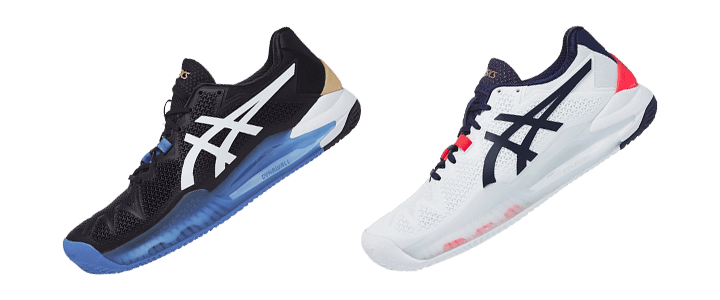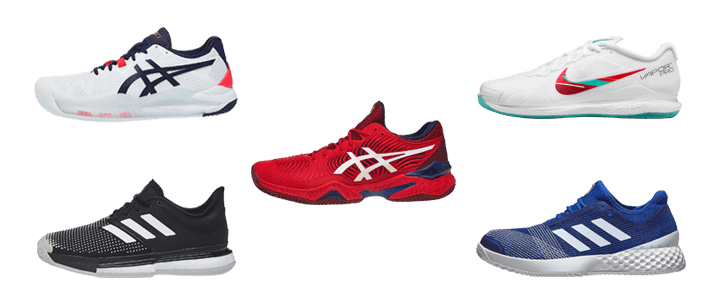Check out my custom vibration dampener
5 Clay Court Tennis Shoes for Men & Women
Best Options + Guide
We hope you love this article. Just so you know, TennisCompanion may collect a small share of sales from the links on this page to help keep this site running. Learn more.
Clay court tennis shoes feature unique design characteristics that allow tennis players to perform their best and maintain maximum comfort on this slick and often challenging surface.
If you play tennis frequently on clay courts, then you may want to consider buying a pair. However, before you take the plunge and make a purchase, there are few things you should keep in mind.
In this guide, we’re exploring the topic of clay court tennis shoes, discussing what makes them unique and how they differ from others and sharing helpful buying considerations.
Plus, we’re reviewing our top picks for the best men’s and women’s clay court tennis shoes, which you’ll find summarized below.
Article Contents
Click below to jump to a section
Tap below to jump to a section
Clay Court Shoes
Clay vs. Hard Court Shoes
Buying a Dedicated Pair
Durability Guarantees
Color Considerations
Best Men’s & Women’s Shoes
New to TennisCompanion?
Create a free account and explore my latest videos below
What is a Clay Court Tennis Shoe?
Clay court tennis shoes are surface-specific footwear that offers unique design characteristics that cater to the demands of clay.
Like all tennis shoes created for the sport, clay court shoes offer essential ingredients such as stability, comfort, and durability.
However, the following attributes are common and distinguish them from other types of tennis shoes.
Outsole
Regardless of the court surface you’re playing on, excellent traction is essential. However, to provide optimal traction, popular tennis shoe brands tweak their outsoles for each type of court.
Clay court tennis shoes most commonly feature a herringbone tread pattern, which runs throughout the entire length of the outsole.

Although it’s not the only style tread in use on clay court shoes, it’s the most popular because it allows players to grip the court and quickly accelerate when moving forward and backward or side to side.
The herringbone tread pattern is also ideal because it allows the clay to move through the outsole during a slide. The result is consistent and predictable slides that are common on this court surface.
Last but not least, the tread pattern releases clay that lodges between the ridges naturally when the shoe flexes. If too much clay becomes stuck within the tread, a player loses traction.
Helpful Tip
Even the best clay court tennis shoes will end up with clay sticking between the grooves of the outsole’s tread – especially if the surface is damp and you’re playing on a finer clay. A simple remedy is to tap the side of your shoe with your racquet to dislodge the clay.
Tight Knit Upper
Although not exclusive to clay court shoes, a more tightly knit or woven upper is common to prevent clay and dust from entering the top of the shoe during play.
On the surface, it might seem like an insignificant detail. However, it’s an incredibly useful design element, which helps ensure your feet stay comfortable while avoiding the mental distraction that comes with clay finding its way under your feet inside the shoe.
Another less important side-benefit that’s worth noting is that your socks will stay cleaner, which may be more or less important to some players.
Helpful Tip
If you’re playing on clay courts, consider wearing black socks, which won’t stain or show the clay-court debris to the same extent.
Differences Between Clay & Hard Court Shoes
Hard courts are by far the most popular surface, but clay courts are also common and prevalent in many countries, particularly in Europe.
Regardless of the court surface, you play on the most frequently, its good to be aware of the differences, so you make the right choice when buying a new pair.
Outsole
Hands down, the most significant distinguishing factor between clay and hard court shoes is the durability of the outsole and tread pattern.
Hard courts are incredibly abrasive, so the outsole for hard courts needs to be more durable for the shoes to last.
Clay courts, on the other hand, are much softer and more forgiving in contrast, so the outsole doesn’t wear nearly as quickly. As a result, the rubber compounds are typically more supple, which also aids in traction.
Furthermore, hard court tennis shoes tend to feature a wide range of tread patterns to maximize traction and durability in critical areas of wear, while clay court shoes almost exclusively use a herringbone pattern.
As a result, while hard court tennis shoes are ideal for this surface, they can also transition and provide players with adequate performance on clay courts as well.
Unfortunately, clay court tennis shoes are not ideal or recommended for hard courts because they lack the necessary durability. If you play on carpet or synthetic grass, clay court shoes will work fine.
Comfort
In addition to their abrasive quality, hard courts are also unforgiving and hard on a player’s feet, joints, and body as a whole. In comparison, clay is much easier on a player’s body because it’s not as firm.
With that in mind, tennis shoes intended for hard courts will typically offer higher levels of comfort, while a clay court model might minimize some of the materials that lend to comfort to keep the weight of the shoe down.
Ventilation
Clay court tennis shoes tend to offer closed or tight-knit uppers to prevent the clay from entering the top of the shoe, which is helpful but can also cut down on a shoe’s breathability.
In contrast, hard court shoes don’t have to worry about dirt and debris entering the top of the shoe during play, so you’ll be more inclined to find shoes that offer relaxed or open mesh to increase ventilation.
It’s not to say that clay court shoes don’t offer any ventilation because they certainly do. However, you’ll find more hardcourt shoes providing exceptional ventilation than you will for clay.
Should You Buy a Dedicated Pair
If you’re learning how to play tennis or have a chance to play tennis on clay for the first time, you might be wondering if you should purchase a new pair of shoes to be well-prepared for your time on the court.
Here are a few factors for you to consider when making the decision.
Frequency of play
In my opinion, the number one determining factor for whether or not you should invest in a pair of clay court tennis shoes is how frequently you play on this court surface.
If your club or local courts are primarily clay and it’s the surface you play on most frequently, then I’d recommend you spring for a pair of clay court tennis shoes because you will get better performance. Plus, you might as well purchase gear that’s ideal for your playing conditions.
If you only play on clay courts a few times a year at most, then it’s unlikely that the investment is worth it.
Level of Play & Competition
If you’re an intermediate to an advanced or competitive player and winning is important to you, then I’d recommend you at least consider investing in a pair of clay court shoes to maximize your performance on this court surface – even if you don’t play on it frequently.
Clay court shoes certainly won’t make or break your success, but you should take advantage of the added benefits unless your working with a tight budget.
Budget
If your budget is tight and all you can afford is an inexpensive pair of tennis shoes for hard courts where you’ll be spending most of your time, then skip the clay-court shoes.
There’s nothing wrong with using your hard court shoes for clay courts, and although it won’t be optimal for clay – they’ll be sufficient.
Of course, if you have the means to buy a pair of clay court shoes because you’ll find yourself playing on it periodically, then, by all means, go for it. It’s certainly not going to hurt.
Durability Guarantees
If you’ve played on hard courts for any length of time, then durability is probably top of mind when buying a new pair of tennis shoes.
However, most of the time, you’re not going to find clay court tennis shoes offering durability guarantees because they won’t wear nearly as fast, which for the most part, makes it a non-issue.
The combination of playing on clay court less frequently combined with the surface not being as abrasive will typically result in clay court shoes lasting far longer than their hard court equivalents for most tennis players.
Color Considerations
If you’re buying a pair of clay court tennis shoes, then one minor consideration worth keeping in mind when selecting them is the color.
Clay can be messy, especially if you’re playing on red clay, so your new tennis shoes are going to be surprisingly dirty after your first few sessions, especially compared to playing on hard courts.
As such, I tend to lean toward models with darker colorways, which do a better job of hiding the mess than a lighter pair.
Of course, if my options were limited, I wouldn’t worry too much about the color, but given the options, you may appreciate a darker pair.
5 Best Men’s & Women’s Clay Court Tennis Shoes
If you’re in the market for a new pair of clay court tennis shoes, then the following five options for men and women are well-worth checking out.
Keep in mind that depending on what country you live in, clay court tennis shoes may be more or less challenging to find.
For example, players in the US will typically have a limited selection, while players in Europe will tend to have a broader range based on the popularity of clay courts.
Asics Court FF 2 – Clay

Our favorite pick for best men’s and women’s clay court tennis shoe is the Asics Court FF 2, which excels across the board.
The outsole makes use of Asics High Abrasion Rubber in a two-piece herringbone style tread for excellent traction on clay. In the middle of the foot, you’ll find its Twisstruss system to prevent the shoe from twisting, which helps provide stability.
For the midsole, Asics treats players to FlyteFoam for maximum lightweight comfort, while their Gel Technology provides shock absorption at the heel and forefoot. A generous Ortholite insole also provides a bit of extra cushion from the start.
Last but not least, the upper delivers comfort through a Mono-Sock fit system, which also makes the shoe easy to put on and take off. At the same time, mesh construction and outer TPU layer combine to keep you comfortable in hotter conditions without sacrificing durability.
Specs
| Size | True |
| Width | Medium |
| Arch Support | Medium |
| Men’s Weight | 14.8 ounces @ size 10.5 |
| Women’s Weight | 12.4 ounces @ size 8.5 |
Nike Air Zoom Vapor Pro – Clay

One of the best-selling models on the market, the Nike Air Zoom Vapor Pro is a lightweight tennis shoe that offers terrific comfort and stability.
The outsole for the Air Zoom Vapor takes advantage of Nike’s extra durable rubber in a herringbone style tread that runs the full length of the shoe. However, this particular sole is unique in that it features generative design, which means the tread runs through the edge of the shoe’s sole and particularly useful on clay tennis courts.
The midsole incorporates a Phylon EVA midsole for comfort, while a Nike Zoom Air unit at the heel provides players with responsive low-profile shock absorption.
For the upper, you’ll find a tightly woven synthetic mesh to prevent clay from entering the shoe and a TPU foot frame at both the inside and outside edge of the shoe for stability. Nike’s Dynamic Fit lacing system allows players to customize the feel of the shoe at various points for personalized comfort.
Specs
| Size | True |
| Width | Medium |
| Arch Support | Medium |
| Men’s Weight | 12.9 ounces @ size 10.5 |
| Women’s Weight | 11.0 ounces @ size 8.5 |
adidas SoleCourt Boost – Clay

The adidas SoleCourt Boost is a super durable and stable tennis shoe that delivers excellent performance for players in the hard court and clay court models.
The Adiwear outsole comes with a full herringbone style tread that’s more generous at the midfoot than the hard court model and delivers excellent traction and sure footing on clay.
For the midsole, the shoe integrates adidas Boost technology for comfort at the heel, which combines with EVA foam at the forefoot. A TPU foot frame rides just above the Boost midsole for stability.
The adidas SoleCourt Boost has a closed upper to prevent any clay from entering through the top of the shoe. Surrounding the front of the shoe’s upper, you’ll find Adituff RPU dots for a protective covering that resists abrasion along with a top cap that sits at the front of the shoe and extends to the inside edge.
Specs
| Size | True |
| Width | Wider in front |
| Arch Support | Medium-high |
| Men’s Weight | 15.7 ounces @ size 10.5 |
| Women’s Weight | 13.7 ounces @ size 8.5 |
Asics Gel Resolution 8 – Clay

Another strong performing clay court tennis shoe is the Asics Gel Resolution 8, which offers stability and comfort.
The shoe’s outsole features the same Asics High Abrasion Resistance rubber that you’ll find in the Court FF 2 but offers more tread in comparison with a smaller cutout for the midfoot shank.
The midsole for the Asics Gel Resolution 8 combines Gel cushioning at the heel and forefoot for shock absorption, while FlyteFoam provides excellent comfort, which is lighter than standard EVA foam.
For the upper, Flexion Fit technology provides form-fitting comfort with an extra durable PU cover for abrasion resistance, which also adds to the stability of the shoe.
Specs
| Size | True |
| Width | Medium |
| Arch Support | Medium |
| Men’s Weight | 14.7 ounces @ size 10.5 |
| Women’s Weight | 12.7 ounces @ size 8.5 |
adidas Adizero Ubersonic 3 – Clay

One of the lighter weight high-end tennis shoes offered by adidas is the Adizero Ubersonic 3, which is an excellent option for clay.
The Adiwear outsole on this clay-court model comes with a herringbone style tread throughout the entire length of the shoe minus an extremely subtle mid-foot cutout for stability.
The midsole takes advantage of adidas SprintFrame technology to help keep a player’s foot closer to the ground, while PU helps ensure responsive comfort.
The upper mixes a breathable mesh Primeknit bootie for comfort, while advanced Dyneema and Vectran fibers add lightweight stability and durability for the top layer.
Specs
| Size | True |
| Width | Medium |
| Arch Support | Medium |
| Men’s Weight | 14.3 ounces @ size 10.5 |
| Women’s Weight | 11.0 ounces @ size 8.5 |
Wrapping Up
If you frequent or play competitively on clay from time to time, then it’s worth investing in a pair of shoes that provide optimal performance and comfort for the surface.
At first glance, the nuances between hard court and clay court shoes might appear subtle, but the distinctions are good to be aware of to help ensure you make an informed purchase.
If you’ve decided hard court tennis shoes are the ideal choice, then be sure to check out our picks for the best tennis shoes.
Hopefully, this guide helped provide some helpful context for what clay court tennis shoes are and when you might want to consider them. If you have any questions, please don’t hesitate to comment below.
Play Better Tennis
Improve your game alongside our community of tennis players
Why join?
Discussion Boards
Join the conversation with other members of the community.
5 Point Friday
Read our weekly recap of the 5 most interesting things we dig up in tennis.



Leave a Reply
Want to join the discussion?Feel free to contribute!